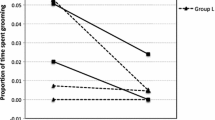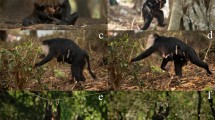Abstract
A female spider monkey (Ateles belzebuth belzebuth) that gave birth to twins was studied during 13 months, and her activity budget and diet were compared to those of females with single offspring and females with no offspring to assess selective pressures that could influence litter size. We recorded qualitative information on the development and social interactions of the twins and three other single infants. Emi, the female that had the twins, had the highest proportion of resting time and the lowest proportion of feeding and moving time compared to other adult females and males. Emi also had the lowest average daily travel distance and relied more heavily on flowers and leaves than other group members who included a higher proportion of fruits in their diets. These results suggest that twins are energetically costly to spider monkeys because of the direct energy allocated into raising and carrying the twins and, also, because these costs have direct effects in the ability of a mother to obtain high-quality resources (e.g., fruits). The twins had a slower rate of physical and social development as well as a smaller body size compared to same-aged singletons by the end of the study. Thus, the extended periods of maternal care and the costs associated with rearing and carrying offspring are some of the factors that influence the evolution and maintenance of a litter size of one in most anthropoid primates.


Similar content being viewed by others
References
Ah-King M, Tullberg BS (2000) Phylogenetic analysis of twinning in Callitrichinae. Am J Primatol 51:135–156
Ahumada JA, Stevenson PR, Quinones MJ (1998) Ecological response of spider monkeys to temporal variation in fruit abundance: the importance of flooded forest as a keystone habitat. Primate Conserv 18:10–14
Bell G, Koufopanou V (1986) The cost of reproduction. In: Dawkins R, Ridley M (eds) Oxford surveys in evolutionary biology. Oxford University Press, Oxford, pp 3:83–131
Bennett EL (1988) The occurrence of twins and accompanying behavioral changes in the banded langur, Presbytis melalophos. Primates 29:557–563
Bicca-Marques JC, Calegaro-Marques (1994) Activity budget and diet of Alouatta caraya: an age-sex analysis. Folia Primatol 63:316–320
Castellanos HG, Chanin P (1996) Seasonal differences in food choice and patch preference of long haired spider monkeys (Ateles belzebuth). In: Norconk NA, Rosemberg AL, Garber PA (eds) Adaptive radiations of neotropical primates. Plenum Press, New York London, pp 451–466
Chapman CA (1989) Ecological constraints on group size in three species of neotropical primates. Folia Primatol 73:1–9
Chapman CA (1990) Association patterns of spider monkeys: the influence of ecology and sex on social organization. Behav Ecol Sociobiol 26:409–414
Chapman CA, Chapman LJ (1986) Development of howling monkey twins (Alouatta palliata) in Santa Rosa National Park, Costa Rica. Primates 27:377–381
Chapman CA, Walker S, Lefebvre L (1990) Reproductive strategies of primates: the influence of body size and diet on litter size. Primates 31:1–13
Charnov EL, Krebs JR (1974) On clutch size and fitness. Ibis 116:217–219
Cody ML (1966) A general theory of clutch size. Evolution 20:174–184
Dietz JM, Baker AJ, Miglioretti P (1994) Seasonal variation in reproduction, juvenile growth and adult body mass in golden lion tamarins (Leontopithecus rosalia). Am J Primatol 34:115–132
Di Fiore A, Campbell C (2005) The atelines: Variation in ecology, behavior, and social organization. In: Campbell CJ, Fuentes AF, MacKinnon KC, Panger M, Bearder S (eds) Primates in perspective. Oxford University Press, Oxford (in press)
Digby LJ, Barreto CE (1996) Activity and ranging patterns in common marmosets (Callithrix jacchus). In: Norconk NA, Rosemberg AL, Garber PA (eds) Adaptive radiations of neotropical primates. Plenum Press, New York London, pp 173–185
Dufour DL, Sauther ML (2002) Comparative and evolutionary dimensions of the energetics of human pregnancy and lactation. Am J Hum Biol 14:584–602
Ellsworth JA, Andersen C (1997) Adoption by captive parturient Rhesus macaques: Biological vs. adopted infants and the cost of being a “twin” and rearing “twins”. Am J Primatol 43:259–264
Estrada A (1982) Surveys and census of howler monkeys (Alouatta palliata) in the rainforest of Los Tuxlas, Veracruz, Mexico. Am J Primatol 2:363–372
Frankie GW, Baker HG, Opler PA (1974) Comparative phonological studies in tropical wet and dry forests in the low-lands of Costa Rica. J Ecol 62:881–919
Froelichk JW, Thorington RW, Otis JS (1981) The demography of howler monkeys (Alouatta palliata) on Barro Colorado Island, Panama. Int J Primatol 2:207–236
Geissman T (1990) Twinning frequency in catarrhine primates. Hum Evol 5:387–396
Gittleman JL, Thompson SD (1988) Energy allocation in mammalian reproduction. Am Zool 28:863–875
Godfray HCJ, Partridge L, Harvey PH (1991) Clutch size. Annu Rev Ecol Syst 22:409–429
Goldizen AW (1987) Tamarins and marmosets: communal care of offspring. In: Smuts BB, Cheney DL, Seyfarth RM, Wrangham RW, Struhsaker TT (eds) Primate societies. University of Chicago Press, Chicago, pp 34–43
Goodall J (1986) The chimpanzees of Gombe: patterns of behavior. Harvard University Press, Cambridge, Mass.
Hsu MJ, Lin JF, Agoramoorthy G (2000) Occurrence of twins in wild Formosan macaques, Macaca cyclopsis, at Mt. Longevity, Taiwan. Folia Primatol 71:154–156
Izawa K (1993) Soil eating by spider monkeys. Int J Primatol 14:229–242
Kimura K, Nishimura A, Izawa K, Mejia CA (1995) Annual changes in rainfall and temperature in the seasonal tropical forest of La Macarena Field Station, Colombia. Field Studies New World Monkeys, La Macarena, Colombia 9:1–3
Lack D (1947) The significance of clutch size. Ibis 89:309–352
Lack D (1954) Natural regulation of animal numbers. Clarendon, Oxford
Leighty KA, Byrne G, Fragaszy DM, Visalberghi E, Welker C, Lussier I (2004) Twinning in tufted capuchins (Cebus apella): rate survivorship and weight gain. Folia Primatol 75:14–18
Leutenneger W (1979) Evolution of litter size in primates. Am Nat 114:525–532
Link A (2003) Insect eating by spider monkeys. Neotrop Primates 11:104–107
Nakamichi M (1983) Development of infant twin Japanese monkeys (Macaca fuscata) in a free-ranging group. Primates 24:576–583
Ogawa H (1998) Adoption and social interactions between a mother and “twin” offspring in Macaca fuscata. Folia Primatol 69:100–105
Pasztor LM, Van Horn RN (1976) Twinning in prosimians. J Hum Evol 5:333–337
Pissinatti A, Coimbra-Filho AF, Rylands AB, Nogueira Rubiao EC (1999) A twin birth in Cebus xanthosternos. Neotrop Primates 7:21–24
Portman (1970) Nutritional requirements (NCR) of non-human primates. In: Harris R (eds) Feeding and nutrition in non-human primates. Academic Press, New York, pp 87–116
Prentice AM, Prentice A (1988) Energy costs of lactation. Annu Rev Nutr 8:63–79
Price EC (1992) The costs of infant carrying in captive cotton-top tamarins. Am J Primatol 26:23–32
Ramos-Fernandez G, Ayala-Orozco B (2002) Population size and habitat use of spider monkeys in Punta Laguna, Mexico. In: Marsh LK (eds) Primates in fragments: ecology and conservation. Plenum/Kluwer Press, New York, pp
Richards AF (1985) Primates in nature. W.H. Freeman and Company, New York
Ross C (2001) Park or ride? Evolution of infant carrying in primates. Int J Primatol 22:749–771
Sanchez S, Pelaez F, Gil-Bürmann C, Kaumanns W (1999) Costs of infant-carrying in the cotton-top tamarin (Saguinus Oedipus). Am J Primatol 48:99–111
Shimooka Y (2005) Sexual differences in ranging of Ateles belzebuth belzebuth at La Macarena, Colombia. Int J Primatol 26:385–406
Sikes RS (1995) Cost of lactation and optimal litter size in northern grasshopper mice (Onychomys leucogaster). J Mamm 76:348–357
Sikes RS (1998) Unit pricing: economics and the evolution of litter size. Evol Biol 12:179–190
Sokal RR, Rohlf FJ (1995) Biometry, 3rd edn. WH Freeman, New York
Stevenson PR (2002) Frugivory and seed dispersal by woolly monkeys at Tinigua National Park, Colombia. PhD thesis, State University of New York at Stony Brook
Stevenson PR, Quinones MJ, Ahumada JA (2000a) Influence of fruit availability on ecological overlap among four neotropical primates at Tinigua National park, Colombia. Biotropica 32:533–544
Stevenson PR, Quiñonez MJ, Castellanos MC (2000b) Guía de los frutos del río Duda, La Macarena, Colombia. Asociación para la defensa de la Macarena-IUCN (Netherlands), Santa Fé de Bogotá
Strier KB (1991) Demography and conservation of an endangered primate, Brachyteles arachnoides. Conserv Biol 5:214–218
Strier KB (1992) Atelinae adaptations: behavioral strategies and ecological constraints. Am J Primatol 88:515–524
Suarez SA (2003) Spatio-temporal foraging skills of White-bellied spider monkeys (Ateles belzebuth belzebuth) in the Yasuni National Park, Ecuador. PhD thesis, State University of New York at Stony Brook
Symington MM (1987) Ecological and social correlates in the black-handed spider monkeys, Ateles paniscus chamek. PhD thesis, Princeton University, N.J.
Tardif SD (1994) Relative energetic cost of infant care in small bodied neotropical primates and its relation to infant care patterns. Am J Primatol 34:133–143
Tardif SD (1997) The bioenergetics of parental behavior and the evolution off alloparental care in marmosets and tamarins. In: Solomon NG, French JA (eds) Cooperative breeding in mammals. Cambridge University Press, Cambridge, pp 11–33
Tardif SD, Harrison ML (1990) Estimates of the energetic costs of infant transport in tamarins. Am J Phys Anthropol 81:306
Taylor TD, Feistner ATC (1996) Infant rearing in captive Hapalemur griseus alaotrensis: singleton versus twins. Folia Primatol 11:229–237
Tuomi J (1990) On clutch size and parental survival. Oikos 58:387–389
Acknowledgements
We thank Dr. Kosei Izawa for motivating and supporting part of this study and providing helpful information on the study groups’ composition and demography. We thank the valuable collaboration and dedicated work of Javier Cajiao. Yukiko Shimooka and Beatriz Ramirez provided helpful assistance in the field. Colin Chapman, Christina Campbell, Pablo Stevenson, Anthony Di Fiore, Luke Mathews, Rachel Dvoskin, and an anonymous reviewer made helpful comments to the manuscript. Pablo Stevenson provided us his phenological data from previous years and gave helpful advice for this study. We thank the ‘Vereda el Tapir’ for kindly receiving us and, in particular, Ramiro Montealegre, Alvaro Sanabria, and Nelson Silva who helped us directly at the study station. The Colombo-Japan agreement through Dr. Kosei Izawa,Carlos Mejia, Akisato Nishimura, and Koshin Kimura has allocated enormous efforts and support to promote research at the CIEM. U.E.S.P.N.N. and the staff from Tinigua National Park provided us with permits and logistical support.
Author information
Authors and Affiliations
Corresponding author
About this article
Cite this article
Link, A., Palma, A.C., Velez, A. et al. Costs of twins in free-ranging white-bellied spider monkeys (Ateles belzebuth belzebuth) at Tinigua National Park, Colombia. Primates 47, 131–139 (2006). https://doi.org/10.1007/s10329-005-0163-7
Received:
Accepted:
Published:
Issue Date:
DOI: https://doi.org/10.1007/s10329-005-0163-7




